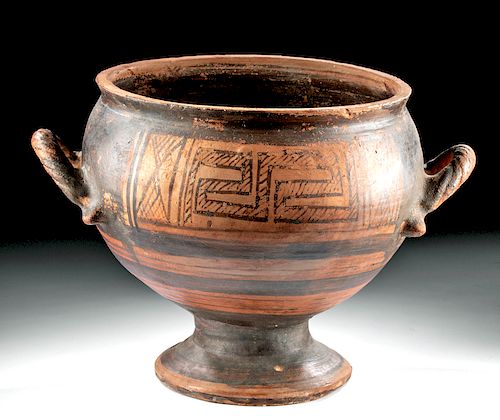Greek Geometric Pottery Krater, ex-Royal Athena
Lot 24
About Seller
Artemis Gallery
686 S Taylor Ave, Ste 106
Louisville, CO 80027
United States
Selling antiquities, ancient and ethnographic art online since 1993, Artemis Gallery specializes in Classical Antiquities (Egyptian, Greek, Roman, Near Eastern), Asian, Pre-Columbian, African / Tribal / Oceanographic art. Our extensive inventory includes pottery, stone, metal, wood, glass and textil...Read more
Estimate:
$3,000 - $6,000
Absentee vs Live bid
Two ways to bid:
- Leave a max absentee bid and the platform will bid on your behalf up to your maximum bid during the live auction.
- Bid live during the auction and your bids will be submitted real-time to the auctioneer.
Bid Increments
| Price | Bid Increment |
|---|---|
| $0 | $25 |
| $300 | $50 |
| $1,000 | $100 |
| $2,000 | $250 |
| $5,000 | $500 |
| $10,000 | $1,000 |
| $20,000 | $2,500 |
| $50,000 | $5,000 |
| $100,000 | $10,000 |
| $200,000 | $20,000 |
About Auction
By Artemis Gallery
Sep 26, 2019
Set Reminder
2019-09-26 10:00:00
2019-09-26 10:00:00
America/New_York
Bidsquare
Bidsquare : Exceptional Day 1: Antiquities & Asian Art
https://www.bidsquare.com/auctions/artemis-gallery/exceptional-day-1-antiquities-asian-art-4437
Day 1 of an important 2-day auction featuring exceptional, museum-worthy examples of Egyptian, Greek, Etruscan, Roman, Viking, Russian, Near Eastern, as well as Asian Art from China, Japan, Thailand, Vietnam, Burma and India. Artemis Gallery info@artemisgallery.com
Day 1 of an important 2-day auction featuring exceptional, museum-worthy examples of Egyptian, Greek, Etruscan, Roman, Viking, Russian, Near Eastern, as well as Asian Art from China, Japan, Thailand, Vietnam, Burma and India. Artemis Gallery info@artemisgallery.com
- Lot Description
East Greek, Geometric Period, ca. 9th to 8th century BCE. An early krater with a rounded, deep body, a convex rim, and a splayed foot below a narrow leg. Twin loop handles project from the middle body, each with spiky attachments at their bases. Around the upper body are frieze panels featuring two hatched meanders framed by metopes with antithetic hatched triangles. The Geometric period saw the rise of grave markers in the form of vases, of which this was likely one. Size: 11.25" W x 7.9" H (28.6 cm x 20.1 cm)
We look to the Geometric period for the roots of Classical Greek civilization as well as the mythos that much of Western culture is built upon: this was when Homer composed the Iliad and the Odyssey, and when graves full of rich and rare metal objects alongside the monumental kraters that served as grave markers told the story of warriors riding into battle in chariots for heroic (or sometimes villainous) rulers. This stunning bracelet would have been a massive sign of wealth, placed into a grave to honor the elite dead and remind others of his or her status in life. Fascinatingly, in the late 8th century BCE, the Greeks stopped filling their graves with beautiful vessels like this one, and deposited small bronze votive figurines instead.
Provenance: private Alabama, USA collection; ex-Roy Green collection; ex-Royal-Athena Gallery, New York, USA, acquired in November 2009; ex-private Swiss collection, acquired in 1961
All items legal to buy/sell under U.S. Statute covering cultural patrimony Code 2600, CHAPTER 14, and are guaranteed to be as described or your money back.
A Certificate of Authenticity will accompany all winning bids.
We ship worldwide and handle all shipping in-house for your convenience.
#148680Expertly repaired and restored on one side. This is well done and difficult to discern, especially on the exterior of the vessel, where it is nearly invisible. Light wear to pigment on surface.Condition
- Shipping Info
-
All shipping is handled in-house for your convenience. Your invoice from Artemis Gallery will include shipping calculation instructions. If in doubt, please inquire BEFORE bidding for estimated shipping costs for individual items.
-
- Buyer's Premium



 EUR
EUR CAD
CAD AUD
AUD GBP
GBP MXN
MXN HKD
HKD CNY
CNY MYR
MYR SEK
SEK SGD
SGD CHF
CHF THB
THB
















